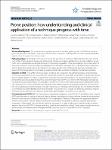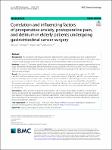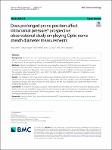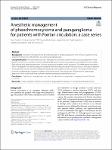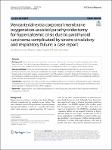Search
Author
- Daqing, Ma (3)
- Alexis, Ferré (2)
- Anna, Lybeck (2)
- Ashish K., Khanna (2)
- next >
Subject
- intensive care unit (8)
- acute respiratory dist... (5)
- chronic obstructive pu... (5)
- ICU (5)
- next >
Has File(s)
Search Results
The findings in CT scans enhanced the use of prone position in ARDS patients. The main mechanism of the improved gas exchange seen in the prone position is nowadays attributed to a dorsal ventilatory recruitment, with a substantially unchanged distribution of perfusion. Regardless of the gas exchange, the primary effect of the prone position is a more homogenous distribution of ventilation, stress and strain, with similar size of pulmonary units in dorsal and ventral regions. In contrast, in the supine position the ventral regions are more expanded compared with the dorsal regions, which leads to greater ventral stress and strain, induced by mechanical ventilation. |
Hypothyroidism is a pathological condition related to a deficiency in circulating thyroid-hormone concentrations [1]. Etiologies are mainly autoimmune thyroiditis, iodine deficiency, post-thyroidectomy or pharmacological, and central due to pituitary or hypothalamic disorders [1, 2]. Although the prevalence of overt hypothyroidism is estimated at 1–2% of the general population [3], hypothyroidism may result in a wide range of severity from subclinical hypothyroidism to exceptional life-threatening myxedema coma (MC). |
Preoperative anxiety is a typical emotional issue among surgical patients. Studies have shown that preoperative anxiety affects patients on both a physiological and a psychological level [1]. Surgery and anesthesia are the main factors that contribute to preoperative anxiety. The incidence of preoperative anxiety in Chinese adults is 16.9%, and female gender and highly invasive surgery have been identified as risk factors for high preoperative anxiety [2]. Preoperative anxiety has been shown to play an important role in modulating postoperative pain [3,4,5,6]. The literature and research are based on the theory of a linear rather than curvilinear relationship between anxiety and pain, meaning that with increased anxiety there is an increase in pain [7]. |
Acute respiratory failure (ARF) is defined by acute and progressive hypoxemia caused by various cardiorespiratory or systemic diseases in previously healthy patients. Among ARF, acute respiratory distress syndrome (ARDS) is a serious condition with bilateral lung infiltration, which develops secondary to a variety of underlying conditions, diseases, or injuries. This review summarizes the current standard of care for ARF and ARDS based on current major guidelines in this field. |
Although invasive methods (intraventricular and intraparenchymal monitors) are still the gold standard in the diagnosis and follow-up of increased ICP, these approaches may cause major complications, such as hemorrhage and infection [8]. Non-invasive alternative methods recommended for the assessment of ICP include the following: measurement of changes in cranial computed tomography (CT) and brain magnetic resonance imaging (MRI), transcranial doppler, tympanic membrane displacement, intraocular pressure, venous ophthalmodynamometry and ONSD [8]. |
Anesthesiology and Perioperative Science (APS) is an open access and peer-reviewed journal which publishes high-quality cutting-edge work of all aspects of anesthesiology, perioperative science and beyond. The publication of the first issue of APS represents a milestone of the development in Anesthesiology-based perioperative medicine, which has the scope far beyond the concepts and practices of the traditional anesthesia care of patients. Launching this journal will likely provide the additional vehicle to advance the research and practice of Anesthesiology and Anesthesiology-based perioperative medicine and science. |
Severe hypothyroidism (SH) is a rare but life-threatening endocrine emergency. Only a few data are available on its management and outcomes of the most severe forms requiring ICU admission. We aimed to describe the clinical manifestations, management, and in-ICU and 6-month survival rates of these patients. |
Fontan circulation is an iatrogenic definitive palliative condition for patients with single ventricle physiology. The patient with Fontan circulation can be sensitive and vulnerable to change systemic vascular resistance (SVR), pulmonary vascular resistance (PVR), and inotropy. Pheochromocytoma and paraganglioma (P-PGL) are neuroendocrine tumors with catecholamine hypersecretion. The number of patients with Fontan circulation and P-PGL is expected to increase because survival rate of the patients is improved and P-PGL have a tendency to develop under cyanotic heart disease [1, 2]. Chronic hypoxia exposure followed by aberrant activation of common hypoxia cellular pathways and hypoxia-inducible factors in chromaffin cells appear to mechanism for the pathogenesis of P-PGL [1]. |
Hypercalcemia crisis is a rare but severe form of hypercalcemia complicated by multiple organ failure. The most common cause of hypercalcemia crisis is primary hyperparathyroidism caused by a parathyroid tumor, which often requires surgical resection [1]. However, there are no clear recommendations on when the surgery should be performed. Although there have been case reports of venoarterial-extra corporeal membrane oxygenation (VA-ECMO) support after cardiac arrest due to hypercalcemia crisis [2], there have been no reports of prophylactic VA-ECMO for circulatory and respiratory failure during surgical treatment of hypercalcemia crisis. In this report, we describe a case in which prophylactic VA-ECMO was used to safely manage circulatory and respiratory failure during parathyroid t... |
After citrate administration, calcium citrate complexes are formed. Clearance in diffusive modes increases with the dialysate flow, in convective modes with filtration flow [12]. Complexes that are not removed through the hemofilter return to the patient. In convective modes up to 60% of the citrate given prefilter is cleared via the hemofilter into the effluent (sometimes more in diffusive modes), the rest returning to the patient for metabolization [12]. Decreasing blood flow limits the amount of delivered citrate to the extracorporeal circuit. Limiting blood flows in convective modes in combination with high filtration rates may lead to a high filtration fraction. Therefore, higher blood flows resulting in a higher delivered citrate dose may be necessary in convective modes, comp... |

